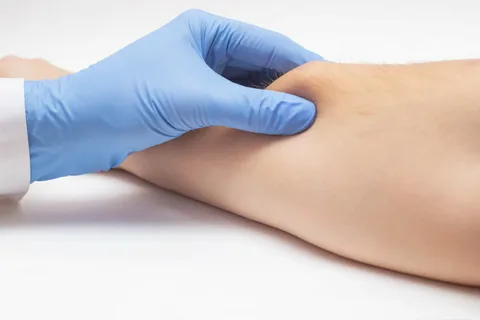Have you ever noticed a soft, rubbery lump beneath your skin and wondered what it could be? For many people, these lumps are harmless lipomas—benign growths of fatty tissue that develop just under the skin. While lipomas are non-cancerous and often painless, they can cause discomfort or cosmetic concerns depending on their size and location. In this situation, lipoma removal becomes a crucial step. Fortunately, we have the best clinic and experts who can hassle-free remove lipoma in your body. However, the patient must not ignore the lipoma symptoms when they start bringing harm to the patient. In this article, we delve into understanding lipomas, their symptoms, and how to manage the discomfort they may cause.
What Are Lipomas
Lipomas are the most common type of soft-tissue tumor, affecting approximately 1 in 1,000 adults globally. They typically occur between 40 and 60 but can appear at any age. These growths comprise fat cells encased in a thin, fibrous capsule, giving them a doughy consistency when touched. Though they can form anywhere on the body, they are most commonly found on the shoulders, back, neck, arms, and thighs.
What Causes Lipomas
The exact cause of lipomas remains unknown, but genetics appear to play a significant role. If you have a family history of lipomas, you’re more likely to develop one. Certain conditions, like adipose dolorosa and Gardner’s syndrome, can also increase the risk. Lifestyle factors, such as physical trauma or injury, have been speculated to contribute, though there is limited evidence to support these claims.
Recognizing Lipoma Symptoms
Lipomas are generally easy to identify by their characteristics:
- Soft Texture: Lipomas feel squishy and move slightly when pressed.
- Painless: Most lipomas are painless, although larger ones can press on nerves and cause discomfort.
- Slow Growth: They develop gradually over months or even years.
- Size: Typically, lipomas range from 1 to 3 centimeters in diameter but can grow much more extensive.
While lipomas are benign, it’s essential to consult a doctor if you notice:
- The rapid growth of the lump
- Pain or tenderness
- Changes in skin color over the lump
- Hard or immovable lumps
These signs could indicate a different condition, such as liposarcoma, a rare but malignant tumor.
How Do Lipomas Affect Daily Life
For many, lipomas are a minor inconvenience, but for others, they can significantly impact quality of life:
- Physical Discomfort: Larger lipomas may interfere with movement or press on nerves, leading to pain.
- Cosmetic Concerns: Visible lipomas on areas like the neck or arms can cause self-consciousness.
- Mobility Issues: Lipomas near joints may hinder range of motion.
Managing Lipoma Symptoms Without Surgery
If your lipoma isn’t causing significant discomfort or cosmetic concerns, monitoring it without intervention is often best. Here are some ways to manage symptoms:
- Pain Relief: Over-the-counter painkillers like ibuprofen can help alleviate discomfort caused by larger lipomas.
- Heat Therapy: A warm compress may improve blood flow and reduce mild soreness.
- Massage: Gentle massage can relieve tension around the affected area but won’t shrink the lipoma.
- Lifestyle Adjustments: Maintaining a healthy weight can prevent additional fatty tissue from forming.
While these methods may provide temporary relief, they don’t eliminate the lipoma.
When Should You Consider Lipoma Removal
Lipoma removal may be the best option for individuals experiencing persistent symptoms or cosmetic concerns. According to insights from Smart Surgeons, a trusted clinic, lipoma removal is a simple outpatient procedure that yields excellent results. Here’s what you should know:
- Surgical Excision: This is the most common method and involves cutting out the lipoma entirely. It’s effective in preventing recurrence.
- Liposuction: Liposuction may be used to suction out the fatty tissue for larger lipomas. While less invasive, this method may not remove the entire capsule, increasing the risk of recurrence.
- Minimal Downtime: Most patients can return to normal activities within a few days after surgery.
Risks and Recovery of Lipoma Removal
Like any medical procedure, lipoma removal carries some risks, including:
- Infection
- Scarring
- Recurrence (in rare cases)
Post-surgery recovery is usually straightforward. Patients are advised to keep the surgical site clean, avoid strenuous activities, and follow their doctor’s instructions for wound care. Contact your healthcare provider immediately if you experience unusual symptoms like fever, redness, or swelling.
When to Seek Medical Advice
You need to pay attention to lipomas if you’re seeing these signs –
- Increase in size
- Pain
- Changes in appearance
- Hardness
- Immobility
Although lipomas are generally harmless, you must consult a doctor if you notice unusual changes, as mentioned above. In most cases, the doctor is advised not to perform any kind of surgery if it is not causing any trouble. However, regular check-ups can help rule out more severe conditions and ensure peace of mind.
Final Thoughts
Living with lipomas doesn’t have to mean living in discomfort. You can effectively manage symptoms and explore removal options if needed with the right approach. Always consult a qualified healthcare professional for a proper diagnosis and treatment plan. If you’re considering lipoma removal, clinics like Smart Surgeons offer state-of-the-art procedures tailored to your needs. Take control of your health and well-being today!
FAQs About Lipomas
Q: Are lipomas cancerous? No, lipomas are benign and non-cancerous. However, it’s crucial to differentiate them from malignant liposarcomas.
Q: Can diet or exercise shrink a lipoma? No, lipomas cannot be reduced through diet or exercise, as they are encapsulated growths of fatty tissue.
Q: Do lipomas grow back after removal? While most lipomas don’t return after surgical excision, recurrence is possible if the capsule isn’t entirely removed.









